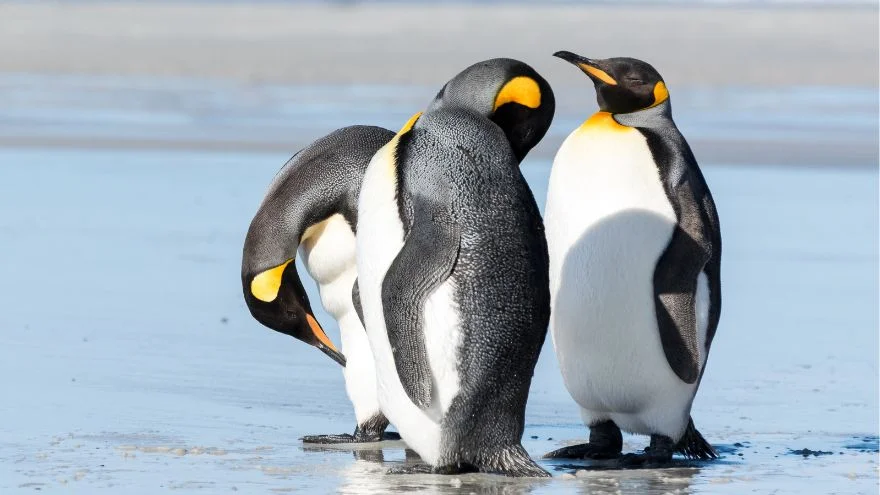A penguin’s body is adapted for swimming, ranging from its large head, short neck, elongated body, and short wedge-shaped tails.
Unlike other birds, penguins have short legs and webbed feet situated far back on their body for waddling.
However, this bird’s unique physical appearance often begs the question “do penguins have knees?”
The answer is yes, penguins have knees. The structural configuration of the bones on a penguin’s leg includes the knees.
However, penguins have knees that are not quite visible because a significant part of the upper leg bones is covered by dense feathers.
Read on to find out more facts about penguin legs, hips, knees, and ankles.
Do Penguins Have Knees?

Penguins have knees that link the femur to the tibia and fibula.
However, because the knees are tucked close to the body and covered with dense feathers, it can be difficult to tell when looking at their outward appearance.
It’s also difficult to see penguins’ knees because their bodies are streamlined to ease swimming and diving.
Another reason you can’t see a penguin’s knees is that their bones are denser than those of other flight birds, as they need to glide through the water, not air.
Their dense bones prevent them from being too buoyant, making it easier to dive deep into the water.
What Do Penguins Use Their Knees For?

The penguins use their knees and feet to propel themselves when they slide around on their stomach.
They also use their knees to move in water and on land. Their knees make it easy for them to shuffle on snow-covered shores and slide on snowy banks.
The tucked-up knees of penguins give them a short-legged appearance, thus reducing their drag when swimming and increasing the speed at which they dive.
These flightless birds also incubate their eggs by holding them close to their knees and balancing them on their toes, all of which help provide warmth for the eggs in cold weather.
Why Do Penguins Waddle When They Have Knees?
Penguins waddle when moving on land or ice because of their short legs and large feet.
Although their legs and webbed feet make them incredible swimmers and divers, walking on land is not convenient.
Additionally, waddling is easily the most adaptable for movement due to its body shape and weight. It is the simplest and most convenient way these birds move about on land and ice.
Interestingly, waddling allows penguins to conserve energy as the energy they use when walking is around two times that of other birds of similar body mass and stature, making waddling an efficient option. 1
Do Penguins Have Hips?
Penguins have hips, the joint where their femur(thigh) bone meets their pelvic bone.
However, their hips are unusual because, unlike most animals, penguins’ hips are very close to their tails due to how far up their knees are.
Do Penguins Have Ankles?
Penguins have ankles like every other bird. However, their ankles differ from other species.
Their ankles are their back-pointing heel, formed by the fusion of the bones in their ankles and the bones of their feet.
Interesting Facts About Penguins

Apart from their hidden knees and webbed feet, there are several interesting things you probably didn’t know about penguins. Some of them include:
- Most penguins share the countershading camouflage—the black and white plumage which assists them in hiding themselves from predators.
- These birds are flightless, so while other birds have wings, they have flippers that make them swim excellently.
- Penguins are one of the most streamlined animals in the world. Their streamlined body design enables them to swim more effectively and efficiently.
- There are about 17 to 19 penguin species, ranging from Australia to Africa.
- These birds are one of the most endangered seabirds, with about two-thirds of their species listed as threatened on the IUCN Red List.
- These creatures are ocean birds and spend about 75 percent of their lives in water and the rest of their lives on ice or land. 2
Frequently Asked Questions
Why do penguins fall over so often?
Generally, penguins can be quite clumsy on land due to the position of their knees. They also fall over more frequently than other birds because of the instability caused by the additional weight they carry in and around their stomachs.
Do penguins’ knees bend backward like other bird species?
Penguins’ knees don’t bend backward. There’s a general assumption that all birds bend their knees backward, but this is not true for the penguin.
The backward-facing leg joint that most assume is their “knee” is their ankle. The penguin’s knees are farther up and don’t bend backward.
Do penguins injure their knees as they fall often?
Penguins don’t injure their knees easily because their bones are strong and very dense. Their knees are also protected since they are tucked close to their bodies and thoroughly covered by thick feathers.
Wrap Up
Penguins are fascinating creatures with unique physical appearances and biological processes.
It’s easy to assume they have no knees when you look at their waddling gait and body posture. However, that’s not the case.
Aside from their knees, penguins also have ankles and hips.
Although their knees are close to their bodies, they are very functional and aid in movement on land, sliding on ice, and incubating their eggs beneath their bodies.
References & Notes
- Griffin, T., Kram, R. Penguin waddling is not wasteful. Nature 408, 929 (2000).
- Danielle H. Penguins. [online] Smithsonian Ocean




